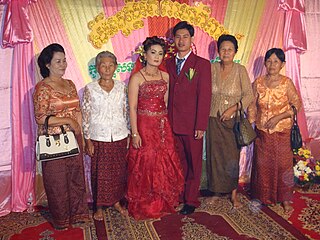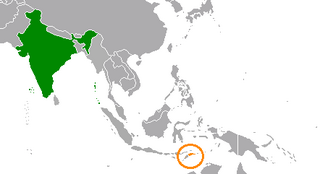Related Research Articles
The history of Cambodia, a country in mainland Southeast Asia, can be traced back to Indian civilization. Detailed records of a political structure on the territory of what is now Cambodia first appear in Chinese annals in reference to Funan, a polity that encompassed the southernmost part of the Indochinese peninsula during the 1st to 6th centuries. Centered at the lower Mekong, Funan is noted as the oldest regional Hindu culture, which suggests prolonged socio-economic interaction with maritime trading partners of the Indosphere in the west. By the 6th century a civilization, called Chenla or Zhenla in Chinese annals, firmly replaced Funan, as it controlled larger, more undulating areas of Indochina and maintained more than a singular centre of power.

The history of Southeast Asia covers the people of Southeast Asia from prehistory to the present in two distinct sub-regions: Mainland Southeast Asia and Maritime Southeast Asia. Mainland Southeast Asia comprises Cambodia, Laos, Myanmar, Peninsular Malaysia, Thailand and Vietnam whereas Maritime Southeast Asia comprises Brunei, Cocos (Keeling) Islands, Christmas Island, East Malaysia, East Timor, Indonesia, Philippines and Singapore.

The Khmer Empire, or the Angkorian Empire, is a term used by historians to refer to Cambodia from the 9th to the 15th centuries, when the nation was a Hindu-Buddhist empire in Southeast Asia. The empire grew out of the former civilizations of Funan and Chenla, which at times ruled over and/or vassalised most of mainland Southeast Asia and parts of Southern China, stretching from the tip of the Indochinese Peninsula northward to the modern Yunnan province of China, and from Vietnam westward to Myanmar.

Funan was the name given by Chinese cartographers, geographers and writers to an ancient Indianized state—or, rather a loose network of states (Mandala)—located in mainland Southeast Asia centered on the Mekong Delta that existed from the first to sixth century CE. The name is found in Chinese historical texts describing the kingdom, and the most extensive descriptions are largely based on the report of two Chinese diplomats, Kang Tai and Zhu Ying, representing the Eastern Wu dynasty who sojourned in Funan in the mid-3rd century CE.

Hinduism in Southeast Asia had a profound impact on the region's cultural development and its history. As the Indic scripts were introduced from India, people of Southeast Asia entered the historical period by producing their earliest inscriptions around the 1st to 5th century CE. Today, Hindus in Southeast Asia are mainly Overseas Indians and Balinese. There are also Javanese and Balamon Cham minority in Cambodia and southern Vietnam who also practice Hinduism.

The post-Angkor period of Cambodia, also called the Middle Period, refers to the historical era from the early 15th century to 1863, the beginning of the French protectorate of Cambodia. As reliable sources are very rare, a defensible and conclusive explanation that relates to concrete events that manifest the decline of the Khmer Empire, recognised unanimously by the scientific community, has so far not been produced. However, most modern historians have approached a consensus in which several distinct and gradual changes of religious, dynastic, administrative and military nature, environmental problems and ecological imbalance coincided with shifts of power in Indochina and must all be taken into account to make an interpretation. In recent years scholars' focus has shifted increasingly towards human–environment interactions and the ecological consequences, including natural disasters, such as flooding and droughts.

Ta Prohm is the modern name of the temple near the city of Siem Reap, Cambodia, built in the Bayon style largely in the late 12th and early 13th centuries and originally called Rajavihara. Located approximately one kilometre east of Angkor Thom and on the southern edge of the East Baray, it was founded by the Khmer King Jayavarman VII as a Mahayana Buddhist monastery and university. Unlike most Angkorian temples, Ta Prohm is in much the same condition in which it was found: the photogenic and atmospheric combination of trees growing out of the ruins and the jungle surroundings have made it one of Angkor's most popular temples with visitors.

The Khmer people are a Southeast Asian ethnic group native to Cambodia. They comprise over 90% of Cambodia's population of 17 million. They speak the Khmer language, which is part of the larger Austroasiatic-language family found in parts of Southeast Asia, parts of central, eastern, and northeastern India, parts of Bangladesh in South Asia, in parts of Southern China and numerous islands in the Indian Ocean.

Hinduism is a minority religion in Cambodia which is followed by nearly 1,000 individuals. Even being a small minority in the Buddhist majority nation it highly influences the vast culture and history of Cambodia with being prominent religion under the Khmer Empire. Today most of the Cambodian Hindus are Indians in Cambodia.

Greater India, or the Indian cultural sphere, is an area composed of many countries and regions in South and Southeast Asia that were historically influenced by Indian culture, which itself formed from the various distinct indigenous cultures of these regions. Specifically Southeast Asian influence on early India had lasting impacts on the formation of Hinduism and Indian mythology. Hinduism itself formed from various distinct folk religions, which merged during the Vedic period and following periods. The term Greater India as a reference to the Indian cultural sphere was popularised by a network of Bengali scholars in the 1920s. It is an umbrella term encompassing the Indian subcontinent, and surrounding countries which are culturally linked through a diverse cultural cline. These countries have been transformed to varying degrees by the acceptance and induction of cultural and institutional elements from each other. Since around 500 BCE, Asia's expanding land and maritime trade had resulted in prolonged socio-economic and cultural stimulation and diffusion of Hindu and Buddhist beliefs into the region's cosmology, in particular in Southeast Asia and Sri Lanka. In Central Asia, transmission of ideas were predominantly of a religious nature.

Chinese Cambodians are Cambodian citizens of Chinese ancestry or Chinese of full or partial Khmer ancestry. The Khmer term Khmer Kat Chen (ខ្មែរកាត់ចិន) is used for people of mixed Chinese and Khmer descent; Chen Khmer (ចិនខ្មែរ) means Cambodian-born citizen with ancestry from China. The Khmer constitute the largest ethnic group in Cambodia among whom Chen means "Chinese". Contact with the Chinese people such as envoys, merchants, travelers and diplomats who regularly visited Indochina verifiably existed since the beginning of the common era. However the earliest record of a Chinese community in Cambodia dates to the 13th century.

The largest of the ethnic groups in Cambodia are the Khmer, who comprise approximately 90% of the total population and primarily inhabit the lowland Mekong subregion and the central plains. The Khmer historically have lived near the lower Mekong River in a contiguous arc that runs from the southern Khorat Plateau where modern-day Thailand, Laos and Cambodia meet in the northeast, stretching southwest through the lands surrounding Tonle Sap lake to the Cardamom Mountains, then continues back southeast to the mouth of the Mekong River in southeastern Vietnam.

The earliest anatomically modern humans skeleton in Peninsular Malaysia, Perak Man, dates back 11,000 years and Perak Woman dating back 8,000 years, were both discovered in Lenggong. The site has an undisturbed stone tool production area, created using equipment such as anvils and hammer stones. The Tambun rock art is also situated in Perak. From East Malaysia, Sarawak's Niah Caves, there is evidence of the oldest human remains in Malaysia, dating back 40,000 years.

Laos is a Buddhist-majority nation with the officially recognised Muslim population approximately constituting 0.01% of the total population as of 2008 census. The majority of Laotian Muslims are Sunni. Laotian Muslims can be found in the capital, Vientiane, which has two mosques, as well as other urban areas such as Savannakhet and Oudomxay; the latter of which had a mosque constructed there in June 2016. Laotian Muslims are an ethnically diverse group, mainly consisting of ethnic Lao, Chin Haw, Chams, Tamils and Pashtuns, with interracial marriages being increasingly popular. They are generally engaged in trade, agriculture, cosmetics, clothing and business though some have attained official roles with the government.
The Indian diaspora in Southeast Africa consists of approximately 3 million people of Indian origin. Some of this diaspora in Southeast Africa arrived in the 19th century from British India as indentured labourers, many of them to work on the Kenya–Uganda railway. Others had arrived earlier by sea as traders.
There is a small Korean community in India, consisting largely of South Korean expatriate professionals and their families, as well as some missionaries and international students at Indian universities.

Overseas Indians, officially Non-Resident Indians (NRIs) and Overseas Citizens of India (OCIs) are Indians who live outside of the Republic of India. According to the Government of India, Non-Resident Indians are citizens of India who are not living in the country, while the term People of Indian Origin (PIOs) are people of Indian birth or ancestry who are not citizens of India, but are citizens of other nations and may additionally have Overseas Citizenship of India (OCI), with those having the OCI status known as Overseas Citizens of India. According to a Ministry of External Affairs report, there are 32 million NRIs and OCIs residing outside India and overseas Indians comprise the world's largest overseas diaspora. Every year 2.5 million Indians migrate overseas, which is the highest annual number of migrants in the world.

Cambodia–India relations, also known as Cambodian-Indian relations, are the bilateral relations between the Kingdom of Cambodia and the Republic of India. Cambodia has an embassy in New Delhi, and India has an embassy in Phnom Penh.
Sachchidanand Sahai is an Indian epigraphist, writer and the scientific advisor to the Government of Cambodia for restoration of Angkor Wat and the Temple of Preah Vihear, known for his knowledge on Khmer civilization. He was honored by the Government of India, in 2012, with the fourth highest Indian civilian award of Padma Shri.

East Timor–India relations are the international relations that exist between East Timor and India. The Embassy of India in Jakarta, Indonesia is concurrently accredited to East Timor. East Timor has no diplomatic representation in India.
References
- ↑ Jacques, Claude (2007-01-01). The Khmer Empire: Cities and Sanctuaries, Fifth to the Thirteenth Centuries. River Books. ISBN 9789749863305.
- ↑ Jacobs, Judith Jacob; Smyth, David (2013-11-05). Cambodian Linguistics, Literature and History: Collected Articles. Routledge. ISBN 9781135338732.
